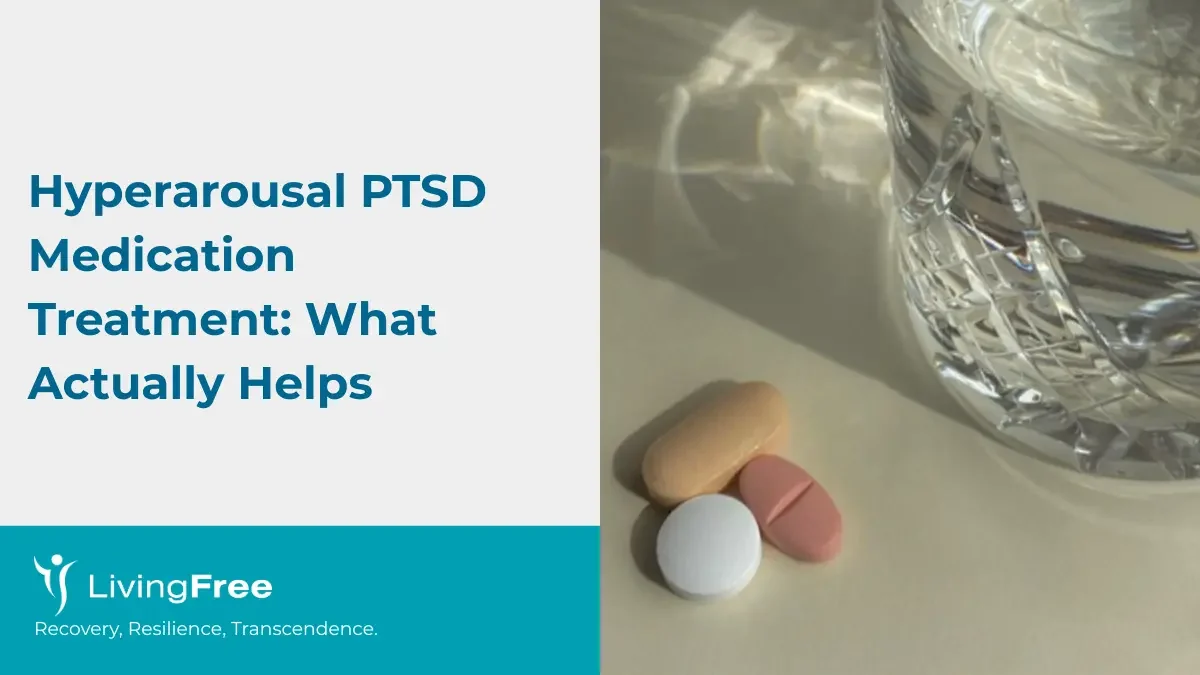Hyperarousal is one of the most overwhelming symptoms of PTSD. It keeps the body stuck in “survival mode,” even when the danger is long gone. Survivors often describe feeling constantly on edge, easily startled, unable to sleep, and exhausted by a nervous system that never rests. Because of this, many look for treatment options, including hyperarousal PTSD medication, treatment that can help bring the body back into balance.
This guide explains everything you need to know about medication treatment for PTSD-related hyperarousal, including what works, when medication is needed, why it requires medical supervision, and how it must be paired with therapy and healthy nervous-system habits for best results.
What Is Hyperarousal in PTSD?
Hyperarousal happens when the brain’s alarm system stays switched on. Instead of calming down once the danger is over, the nervous system keeps reacting as if the threat is still here.
Common symptoms include:
- Persistent insomnia or restless sleep
- Nightmares and night terrors
- Irritability or sudden anger
- Feeling constantly alert or “on guard”
- Difficulty concentrating
- Racing heartbeat, trembling, sweating
- Being startled easily
These symptoms are not signs of weakness. They are the body’s protective instincts stuck in overdrive.
Where Medication Fits Into Hyperarousal Treatment
Experts consistently emphasize:
Medication helps reduce symptoms, but it is not the main or only treatment for PTSD.
The first-line treatments remain trauma-focused psychotherapies such as:
- EMDR.
- Cognitive Processing Therapy (CPT).
- Prolonged Exposure (PE).
- Trauma-focused CBT.
Medication is typically added when:
- Symptoms are severe.
- Therapy alone isn’t enough.
- Seep disturbances block recovery.
- Daily functioning becomes difficult.
- Survivors cannot begin therapy because their body is too dysregulated.
- Comorbid depression or anxiety intensifies PTSD.
Medication creates stability so survivors can engage more effectively in therapy and daily life.
Important: PTSD Medication Is Not Something You Can Take Casually
Medications used for PTSD hyperarousal affect blood pressure, heart rhythm, sleep cycles, and neurological activity. Because of this, they cannot be taken without professional assessment.
Reasons medical supervision is essential:
- Some medications require slow dose titration.
- Many need regular blood pressure monitoring.
- Some are off-label and require informed consent.
- Interactions with alcohol, caffeine, or other medications must be reviewed.
- Underlying conditions (like sleep apnea) must be ruled out first.
This is not the type of medication you can “just try.” A qualified clinician must evaluate whether it’s safe and appropriate.
Hyperarousal PTSD Medication Treatment Options
1. SSRIs & SNRIs (First-Line Medication Treatment)
These antidepressants reduce overall PTSD symptoms, including hyperarousal. Common prescriptions:
- Sertraline
- Paroxetine
- Fluoxetine
- Venlafaxine
These medications work by increasing serotonin or norepinephrine levels in the brain, which helps stabilize mood, improve emotional regulation, and reduce overall hyperarousal intensity. They also target co-occurring depression and anxiety, which often worsen PTSD symptoms. Although they take several weeks to work, they remain the most researched and widely recommended medication class for PTSD.
2. Prazosin: For Nightmares & Sleep-Related Hyperarousal
Prazosin is one of the most frequently used medications for:
- Nightmares.
- Night sweats.
- Sleep-related anxiety.
- Nighttime hypervigilance.
Prazosin blocks the effects of adrenaline on the body, especially during sleep. By reducing nighttime surges of noradrenaline, it can lessen nightmares, night sweats, and nighttime panic. Many survivors report their first “real sleep” in years after finding the right dose. Because it affects blood pressure, dosing must be increased slowly under supervision.
3. Alpha-Agonists & Related Medications (Clonidine, Guanfacine, Terazosin)
These may help with:
- Hypervigilance.
- Exaggerated startle response.
- Nighttime arousal.
These medications calm the sympathetic nervous system by reducing adrenaline output. They can decrease hypervigilance, irritability, and exaggerated startle response. Clonidine and guanfacine are also used in ADHD, which is why some survivors with attention issues benefit from them. Terazosin works similarly to prazosin but may help those who don’t respond to prazosin.
4. Beta-Blockers (Propranolol)
Helpful for:
- Racing heart.
- Shaking.
- Adrenaline surges.
Beta-blockers reduce the physical symptoms of hyperarousal by blocking adrenaline’s effect on the heart and muscles. This helps steady a racing heartbeat, decrease shaking, and reduce the “rush of fear” sensation. While they don’t address emotional trauma directly, they can help survivors regain a sense of physical control, especially during heightened periods of stress.
5. Atypical Antipsychotics (e.g., Quetiapine)
Can help with:
- Severe insomnia.
- Agitation.
- Emotional dysregulation.
These medications influence dopamine and serotonin pathways to help regulate intense emotional activation. Low doses are often prescribed for severe insomnia or nighttime agitation. In some cases, they can also reduce intrusive thoughts or extreme irritability. Because they may cause sedation or metabolic side effects, clinicians use them cautiously and typically only when other treatments haven’t provided enough relief.
6. Benzodiazepines: Not Recommended
Although they may temporarily reduce anxiety, benzodiazepines:
- Do not treat PTSD
- Increase dependency risk
- May worsen hyperarousal long-term
Benzodiazepines work by enhancing the brain’s calming neurotransmitter (GABA), which temporarily reduces panic and anxiety. However, because they act quickly and powerfully, the body can become dependent on them. They also interfere with therapy progress and may worsen long-term hyperarousal. This is why clinicians avoid prescribing them for PTSD, except in very short-term or emergency circumstances.
When Do Survivors Actually Need Medication?
Clinicians typically consider medication when:
1. Trauma-focused therapy isn’t enough on its own
If symptoms remain overwhelming despite consistent therapy, medication may help reduce the nervous system’s reactivity.
2. Symptoms significantly disrupt daily life
For example:
- Sleeping only 2–3 hours per night.
- Constant hypervigilance or panic.
- Anger bursts affecting relationships.
- Inability to focus at work.
3. Hyperarousal blocks the ability to begin therapy
Some survivors are too depleted or too dysregulated to engage in therapy effectively.
4. Nightmares or sleep issues become chronic
Prazosin or related medications may be used when sleep disturbance is severe.
5. Other supportive treatments haven’t fully worked
If lifestyle changes, grounding techniques, and therapy have been tried consistently but symptoms persist, medication becomes an option.
Medication is never a failure, it is a tool to support your healing.
Medication Must Be Combined With Therapy and Nervous-System Support
Medication helps reduce symptoms, but it cannot heal trauma on its own. The best outcomes occur when medication is paired with:
1. Trauma-focused therapy
To address the root causes of PTSD
2. Nervous-system regulation habits. Such as:
- Slow diaphragmatic breathing
- Progressive muscle relaxation
- Grounding exercises
- Gentle movement (walking, stretching)
- Mindfulness or somatic practices
3. Sleep-focused habits
Stable routines, reduced screen time at night, lower stimulant intake.
4. Supportive lifestyle changes
- Regular meals
- Hydration
- Moderate exercise
- Reducing chronic stress where possible
These daily habits strengthen your parasympathetic nervous system and make medication more effective.
FAQ: Hyperarousal PTSD Medication
1. Do survivors need to take these medications for life?
Not usually. Many people take medication only during the more intense phases of their healing. Once therapy progresses and symptoms stabilize, the dosage may be reduced or the medication may be stopped—always under medical supervision.
2. Is it dangerous to stop medication abruptly?
Yes, abruptly stopping can cause withdrawal, rebound anxiety, or blood-pressure changes. Always taper under a doctor’s guidance.
3. Can medication cure PTSD?
Medication can reduce symptoms, but it does not cure PTSD. Healing requires therapy, emotional processing, and nervous-system regulation.
4. Are these medications addictive?
Most PTSD medications are not addictive. The exception is benzodiazepines, which are usually avoided for PTSD.
5. What if medication doesn’t work for me?
Everyone responds differently. It may take trying another medication or adjusting the dosage. The goal is not perfection but relief and stability.
6. Can medication replace therapy?
No. Medication can make therapy easier, but it cannot resolve trauma memories or patterns by itself.
7. How long does it take to notice improvements?
SSRIs/SNRIs often take 4–8 weeks. Prazosin and alpha-agonists may help sooner, especially with sleep.
8. Is it normal to feel nervous about taking medication?
Absolutely. Many survivors feel unsure. A good clinician will explain options clearly, discuss side effects, and work collaboratively with you.
Final Thought
Medication can be an incredibly helpful tool for PTSD hyperarousal, especially when nightmares, insomnia, or constant body tension make daily life feel unmanageable. But it works best when used thoughtfully: with medical supervision, together with therapy, and supported by habits that help regulate the nervous system. You deserve relief, and you deserve support. If you’re struggling, reaching out to a clinician experienced in trauma can be the first step toward feeling safe in your own body again.
Related Reading:


